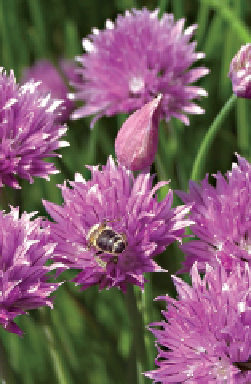Agriculture Reference
In-Depth Information
PROPAGATION
Chives are another of those alliums that can be propagated vegetatively by dividing
plants or generatively by seed. Germination rates of chive seeds are high only in the first year, so use
fresh seed. Plants are perennial and bring forth many pink or purple flowers every year. Most newer
varieties do not flower and can only be propagated vegetatively. Chives do best when rejuvenated
every two to three years by digging up, dividing, and replanting elsewhere in the garden where they or
other alliums have not been grown recently. The more chives are cut back, the more they tiller. Drying
out in the summer can kill chive plants.
For bouquets and ornamental gardens: the pink and purple flowers of chives
HARVEST
Seeds ripen in mid to late summer. Cut seedheads, dry, and thresh.
SELECTION CHARACTERISTICS
• vigorous growth and frequent harvestability
• minimal or late tendency to flower
• tender or strong hollow leaves
• resistance to disease
• good, spicy aroma, no soapy aftertaste
DISEASES AND PESTS
Chives are susceptible to the same diseases and pests as the common onion.
The most common disease is rust (
Puccinia allii
), which mainly affects chives and leeks and can cause
large reductions in yield. This fungus often shows up in late summer/early autumn in wet years and
thrives best in very high humidity and temperatures in the 50-75°F (10-24°C) range. Symptoms:
round or elongated orange spots with tears, the entire plant turns a lighter shade of green. Prevention:
apply horsetail (
Equisetum arvense
)/clay slurry to plants in high-risk areas.
CULTIVATION HISTORY
Chives were domesticated several times in several different places from vari-
ous wild populations. They were first documented in Europe in Charlemagne's
Capitulare de Villis
.
Wild chives retract in summer; they grow in the mountainous areas of North America, Europe, and

